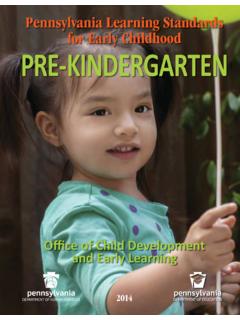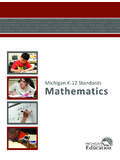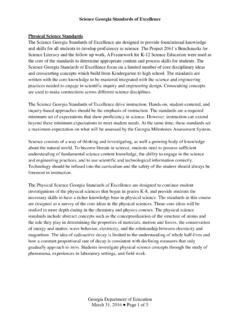Transcription of Practices for Science Investigation Kindergarten …
1 Virginia Department of Education November 2012 Practices for Science Investigation Kindergarten -Physics Progression 2010 Science standards of learning Introduction1 Proficiency Advanced Mastery GRADE/COURSE OBSERVING K 1 2 3 4 5 6 LS PS ES BI CH PH Basic characteristics or properties of objects are identified by direct observation. ( ) 1 Observations are made from multiple positions to achieve different perspectives. ( ) The senses are used to observe differences in physical properties. ( ) Observations are made from multiple positions to achieve a variety of perspectives and are repeated to ensure accuracy.
2 ( ) Simple tools are used to enhance observations. ( ) Observations and predictions are made and questions are formed. ( ) Observation is differentiated from personal interpretation. ( ) Observations are repeated to ensure accuracy. ( ) Observations are made and are repeated to ensure accuracy. ( ) 2 Distinctions are made among observations, conclusions, inferences, and predictions. ( ) Observations are made involving fine discrimination between similar objects and organisms. ( ) 3 Observations of living things are recorded in the lab and in the field. ( ) 4 Instruments are selected and used to extend observations and measurements of mass, volume, temperature, heat exchange, energy transformations, motion, fields, and electric charge.
3 ( ) 5 1. Proficient performance on an introduced skill in routine classroom tasks and performances is expected by the end of grade-level/course instruction unless indicated by multiple introductory year blocks. 2. The standard segment repeats the previous segment, , which introduces the disposition of repeated trials. Therefore this is not a newly introduced skill, and grade-appropriate proficient performance for this basic skill is expected by the end of third grade. 3. Fine discrimination is somewhat discipline specific depending on the complexity of the subject matter and the experiences of the observer. For example, discerning the difference between two somewhat similar rocks ( ) or organisms ( ) requires honing observational skills (practice) and deeper knowledge of specific descriptive terminology.
4 4. The skill was introduced in standard segment a. The skill is used in a discipline-specified context in this high school course, with the expectation that students will have rigorous inquiry experiences in the field/laboratory setting, building work and postsecondary education readiness. 5. The additional context of measuring fields and electric charges, usually reserved for high school physics, qualifies this as an introduction-level skill. Virginia Department of Education November 2012 Practices for Science Investigation Kindergarten -Physics Progression 2010 Science standards of learning Introduction1 Proficiency Advanced Mastery GRADE/COURSE CLASSIFYING AND SEQUENCING K 1 2 3 4 5 6 LS PS ES BI CH PH A set of objects is sequenced according to size.
5 ( ) 1 A set of objects is separated into two groups based on a single physical characteristic. ( ) Objects or events are classified and arranged according to characteristics or properties. ( ) Two or more characteristics or properties are used to classify items. ( ) Objects with similar characteristics or properties are classified into at least two sets and two subsets. ( ) Natural events are sequenced chronologically. ( ) Objects or events are classified and arranged according to characteristics or properties. ( ) 2 Items such as rocks, minerals, and organisms are identified using various classification keys.
6 ( ) A classification system is developed based on multiple attributes. ( ) 1. Proficient performance on an introduced skill in routine classroom tasks and performances is expected by the end of grade-level/course instruction unless indicated by multiple introductory year blocks. 2. This standard segment is introduced as and is repeated here because of its crucial place in the classification skills hierarchy. Virginia Department of Education November 2012 Practices for Science Investigation Kindergarten -Physics Progression 2010 Science standards of learning Introduction1 Proficiency Advanced Mastery GRADE/COURSE COMMUNICATING K 1 2 3 4 5 6 LS PS ES BI CH PH Observations are recorded.
7 ( ) 1 Picture graphs are constructed. ( ) Objects are described both pictorially and verbally. ( ) Observations and data are recorded, analyzed, and communicated orally and with simple graphs, pictures, written statements, and numbers. ( ) (Analyzing Data)* Data are collected and recorded, and bar graphs are constructed using numbered axes. ( ) Observations and data are communicated. ( ) Data are gathered, charted, graphed, and analyzed. ( ) Data are communicated. ( ) Data are collected, recorded, analyzed, and displayed using bar and basic line graphs. ( ) Data are communicated with simple graphs, pictures, written statements, and numbers.
8 ( ) Data are collected, recorded, analyzed, and communicated using proper graphical representations and metric measurements. ( ) (Analyzing Data) Data are collected, recorded, analyzed, and reported using metric measurements and tools. ( ) (Measuring) Data are analyzed and communicated through graphical representation. ( ) (Analyzing Data) Data are organized into tables showing repeated trials and means. ( ) Data are organized, communicated through graphical representation, interpreted, and used to make predictions. ( ) Numbers are expressed in scientific notation where appropriate. ( ) 2 Data tables showing the independent and dependent variables, derived quantities, and the number of trials are constructed and interpreted.
9 ( ) (Analyzing Data) Data tables for descriptive statistics showing specific measures of central tendency, the range of the data set, and the number of repeated trials are constructed and interpreted. ( ) (Analyz. Data) 3 Frequency distributions, scatterplots, line plots, and histograms are constructed and interpreted. ( ) 4 Virginia Department of Education November 2012 Introduction1 Proficiency Advanced Mastery GRADE/COURSE COMMUNICATING K 1 2 3 4 5 6 LS PS ES BI CH PH Experimental results are presented in appropriate written form. ( ) Scales, diagrams, charts, graphs, tables, imagery, models, and profiles are constructed and interpreted.
10 ( ) (Modeling, Analyzing Data) 5 Appropriate technology including computers, graphing calculators, and probeware, is used for gathering and analyzing data, communicating results, modeling concepts, and simulating experimental conditions. ( ) (Modeling, Analyzing Data) Research utilizes scientific literature. ( ) Accurate recording, organization, and analysis of data through repeated trials. ( ) (Analyzing Data) Use of appropriate technology including computers, graphing calculators, and probeware, for gathering data, communicating results, and using simulations to model concepts. ( ) (Modeling) 6 Construction and defense of a scientific viewpoint.


















